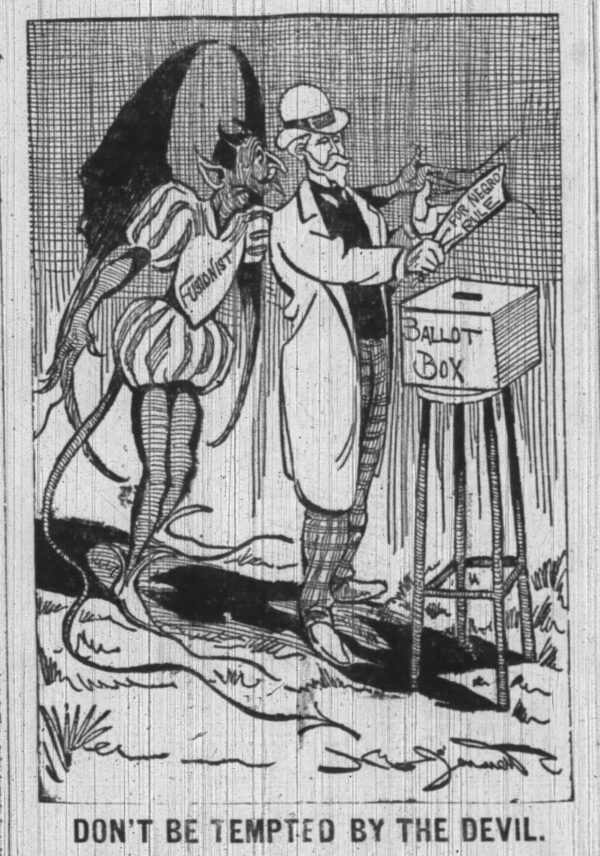The Wilmington Massacre and Coup d’état of 1898 stands as a grim reminder of the racial tensions and political upheaval that plagued the United States during the late 19th century. This event, which took place in Wilmington, North Carolina, marks one of the most violent incidents of white supremacy and racial intimidation in post-Reconstruction America.
The Reconstruction era following the Civil War brought hope for Black Americans as they gained political and economic opportunities. However, this progress was met with deep-seated resentment among white conservatives, who sought to reestablish white political dominance and suppress Black progress. When economic strife brought together working class white and Blacks to form a Fusionist government, elite white North Carolinians began to feel their control of the state was at risk. By the late 1800s, white supremacist ideologies were on the rise, fueled by fears of Fusionist political dominance and Black social, economic, and political advancement.
In the years leading up to the Wilmington Massacre and Coup d’état of 1898, Wilmington had become a prosperous and racially diverse city. Black citizens played a significant role in the local government, with successful businesses and positions of influence. According to “The Ghosts of 1898” by Timothy Tyson, Black citizens owned 10 of the 11 eating houses and 20 of the 22 barbershops in the city. Education for the Black community was robust as well, with Black men having a higher rate of literacy than white men in the area. This progress and integration threatened the white power structure, sparking a campaign of fear and intimidation.
In August of 1898 Mrs. Rebecca Latimer Felton, a prominent white suffragist and advocate for white supremacy, delivered a controversial speech known as “Woman on the Farm.” In her speech, Felton promoted the idea that white women needed to protect their homes and the purity of their race from the perceived threat of Black men. Her words further fanned the flames of racial animosity and contributed to the atmosphere of fear and violence that led to the coup.
Alex Manly, a Black newspaper editor, penned a powerful editorial in response to Felton’s speech. In his editorial, published in the Daily Record, a Black-owned newspaper, Manly challenged the white supremacist narrative and openly discussed interracial relationships. He argued that the rape of Black women by white men was far more prevalent than consensual relationships between Black men and white women. Manly’s bold editorial challenged the prevailing racist ideology and became a lightning rod for white supremacists.
The contrasting perspectives of Mrs. Rebecca Latimer Felton and Alex Manly highlight the power of words and media in shaping public opinion during this turbulent period. Felton’s speech perpetuated racist ideologies and contributed to the atmosphere of fear and violence, while Manly’s editorial challenged the prevailing narrative and advocated for racial equality. For white community members who were barraged every day with racist editorial cartoons and headlines for months leading up to the election of 1898, Manly’s contradictory opinion became a flash point.
On November 10, 1898, a group of armed white supremacists, including former Confederate army officers and local politicians, launched a coordinated attack on the city of Wilmington. This violent assault aimed to overthrow the newly elected biracial government and replace it with a white-only administration. The white supremacists employed a combination of physical violence, threats, and voter suppression tactics to achieve their goals.
Black businesses were systematically destroyed, their leaders ousted from positions of power, and many Black residents killed or forced to flee the city. The mayor, police chief, and board of alderman were removed from office at gunpoint, and Aldred M. Waddell was “elected” mayor. The violence and chaos that ensued during the Wilmington Massacre left an indelible mark on the community and forever altered the racial dynamics of the city. The coup successfully replaced the biracial government with a white supremacist regime, entrenching white political dominance and reinforcing racial divisions for decades to come.
Alexander Manly’s editorial and his unwavering commitment to truth and justice made him a target of the white supremacist mob. His newspaper office was burned down, and he, along with other Black community leaders, faced threats and violence. In response to demands from the coup’s leaders, Black community leaders agreed to encourage Manly to leave town. Before he could leave of his own accord, Manly was marched out of town by coup participants.
The effects of the Wilmington Massacre and Coup d’état of 1898 reverberated far beyond the city limits. It served as a rallying cry for white supremacist movements across the nation, emboldening them to further suppress Black citizens’ political and civil rights. The incident also had a chilling effect on Black peoples’ participation in the political process, as they faced widespread intimidation and violence when attempting to exercise their right to vote.
Moreover, the events in Wilmington highlighted the racism and inequality that persisted during the post-Reconstruction era. The coup exposed the fragility of Black progress and the vulnerability of racial minorities in the face of white supremacist violence. It served as a stark reminder of the long-lasting struggle for racial equality and the oppressive forces that sought to deny Black Americans their rights and opportunities.
In recent years, efforts have been made to uncover and acknowledge the true extent of the Wilmington Massacre and Coup d’état of 1898. Historians, activists, and community members have worked to ensure that this dark chapter in American history is not forgotten and that its lessons are learned. The events in Wilmington provide a sobering reminder of the ongoing fight against racism and the importance of upholding and defending the principles of equality and justice for all.
In conclusion, the Wilmington Massacre and Coup d’état of 1898 stands as a tragic testament to the racial tensions and political upheaval that marred the late 19th century in the United States. This event serves as a stark reminder of the racism that plagued the nation during this era and the long-lasting struggle for racial equality.


